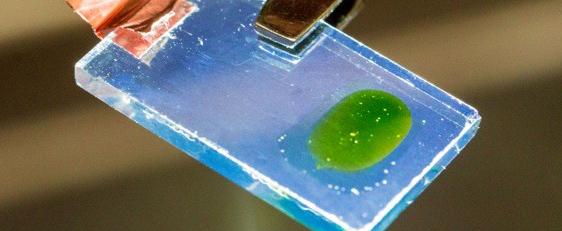For many years, scientists have been trying to learn new tricks from leaves, and now Dr Nicolas Plumeré from the Ruhr-University Bochum, in Germany, and his colleagues have finally succeeded in beating nature at its own game.Backed by a European Union COST Action grant and the German Research Foundation, the researchers have developed a semi-artificial leaf that incorporates a protein found in real leaves and is responsible for transporting electrons during photosynthesis.They isolated the protein from an algae found living in hot springs in Japan. But inserting the protein into their artificial leaf was no easy task.‘This protein complex comes from the membrane of the algae which is a hydrophobic (water avoiding) environment,’ said Dr Plumeré. ‘We first needed to make it hydrophilic (water attracting) in order to dissolve it and mix it with the polymers we use. Once incorporated into the artificial leaf we then had to bring it back into a hydrophobic environment.’Flipping proteinsThe scientists found a way to flip the protein from hydrophilic to hydrophobic by altering the acidity of the environment, and in this way managed to incorporate it into their artificial leaf. Plumeré and his colleagues found that the artificial leaf transported electrons over seven times faster than areal leaf.However, it is not just the speed of electron transfer that is causing excitement. ‘Unlike silicon, which is rigid and opaque, this new material is fully transparent and flexible. It can be applied like a paint, to produce a very thin layer,’ Dr Plumeré said. And its natural ingredients mean that it is less likely to be rejected by the body if incorporated into medical devices.“‘This new material is fully transparent and flexible.’Dr Nicolas Plumeré, Ruhr-University Bochum, GermanyDr Plumeré and his colleagues are exploring the possibility of using their semi-artificial leaf to power micro-sized medical devices, such as sensors implanted in contact lenses. ‘Such a device could monitor a person’s tears and collect information on diabetes for example,’ he said.In order to make this idea a reality, the semi-artificial leaf also needs to be low cost. Currently it takes one person more than two weeks to make just 10 milligrams – enough to make one square metre of semi-artificial leaf.But if production was scaled up, he is confident that it would become cheap enough to incorporate into relatively short-lived products. ‘We envisage that it could be used in clothing. Rather than queuing for power sockets at the airport, you could charge your smartphone or laptop from a solar battery on the sleeve of your coat, as long as there is sunshine of course,’ he said.Other European Union projects are also taking their inspiration from natural photosynthesis. The European Research Council’s PhotoCatH2ode project exploits the metabolism of a particular type of micro-algae which uses solar energy to split water into hydrogen and oxygen.‘As far as the energetic aspect is concerned, the photosynthetic process is a fascinating example of efficiency, and highly attractive for the development of novel hydrogen production technologies,’ explained Dr Vincent Artero, from the Université Joseph Fourier in Grenoble, France.Together with his colleagues, he aims to incorporate bio-inspired catalysts into their own version of a semi-artificial leaf, which could then be used to produce plentiful hydrogen as a renewable form of energy.
This article was originally published in Horizon, the EU Research and Innovation magazine.
Add to favorites:
Share:
Listing Description
Video
Documents
No documents available.
Ask KETMarket to make a contact
Connect with the Listing Owner!
💬 Please log in now to askKETMarket to make a contact. Not a member yet? Sign up for free and start connecting today!
Video
Related Funding and Finance Opportunities
Unlock Exclusive Funding Opportunities!
🔑 Get instant access to tailored funding opportunities that perfectly match your needs. This powerful feature is exclusively available to our premium members—helping you save time, stay ahead of the competition, and secure the right funding faster.
Upgrade to Premium now and never miss an important opportunity again! Already a premium member? Log in here to explore your matches.
Related Innovation Offers
Discover Tailored Innovation Offers!
🚀 Gain access to technology solutions that match your specific needs and interests—carefully selected to support your innovation goals. These offers are exclusively available to our premium members, helping you identify relevant technologies faster and start the right conversations with potential partners.
Upgrade to Premium now and explore your personalized technology matches today! Already a premium member? Log in here to view your tailored offers.
Related Knowledgeable Resources
Discover More with Premium: Related Knowledge Resources
🔒 You’re missing out on expert-curated knowledge specifically matched to this topic. As a Premium member, you gain exclusive access to in-depth articles, guides, and insights that help you make smarter decisions, faster.
Whether you’re preparing a funding proposal, researching a new market, or just need reliable information—our Premium knowledge matches save you hours of research and point you directly to what matters.
Upgrade to Premium now and instantly unlock relevant knowledge tailored to your needs! Already a member? Log in here to view your personalized content.

